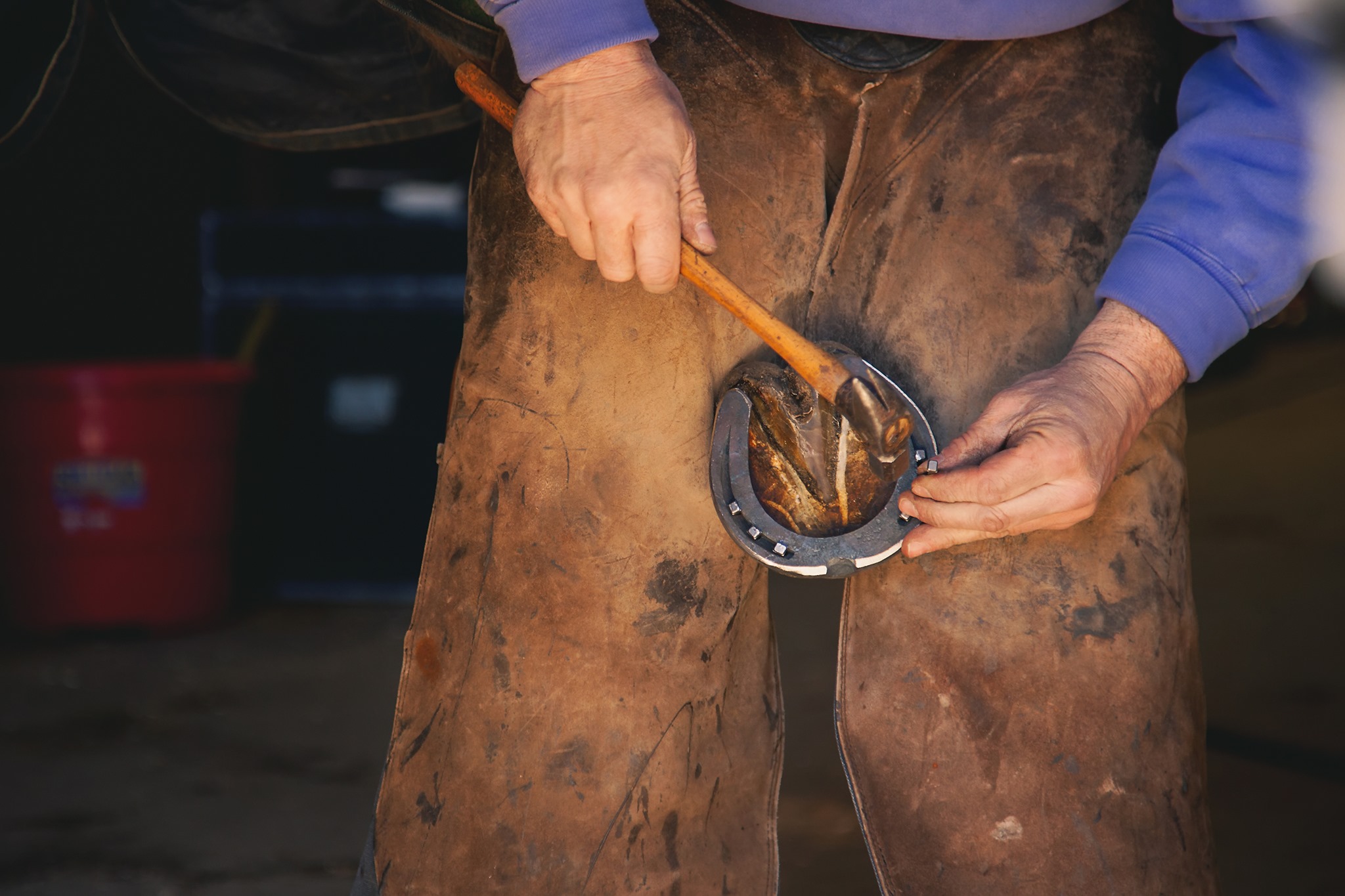Hoof health in performance horses plays a crucial role, as the condition of an equine’s hooves directly influences their overall well-being and athletic capabilities. The hoof is the foundation for a horse's entire musculoskeletal system, supporting their weight, absorbing shock, and facilitating precise movements essential for various performance disciplines such as racing, roping, jumping, dressage, and more.
Hooves are the cornerstone of performance in your horse. A healthy hoof is so much more than a protective casing for the underlying structures. That is why understanding the importance of hoof health is not just a matter of sustaining an equine’s physical well-being; it is a key factor in unlocking the full potential and longevity of a performance horse's career.
The Importance of Healthy Hooves in a Performance Horse
Hoof health and care is a major component for ensuring your equine's sound well-being and optimal performance. Proper hoof care not only allows your horse to be comfortable but also prevents multiple hoof-related ailments that can lead to pain and discomfort.
Let's understand why your horse's hoof health is important to their overall well-being.
Shock Absorption
Your horse's hooves are natural shock absorbers. They help to cushion the impact of each step a horse takes. Healthy hooves are much better at distributing and absorbing the forces that occur during movement, helping to reduce the risk of injuries and minimizing stress on joints, tendons, and ligaments.
Balance & Stability
Well-maintained performance horse hooves contribute to proper balance and stability, enabling your equine to move efficiently and comfortably. Balance is essential for precise movements and can impact a horse's ability to perform specific tasks, especially in disciplines that require agility and precision.
Pain Prevention
Poor hoof health can lead to discomfort, pain, and even lameness. A performance horse with healthy hooves is more likely to be free from pain, allowing it to perform at its best without being hindered by issues such as street nails, abscesses, or other hoof-related problems.
Traction
Proper traction is crucial in performance disciplines involving rapid stops, turns, and varied terrain. Healthy hooves with well-maintained hoof walls and the right balance contribute to better traction, reducing the risk of slipping and improving overall performance.
Longevity of Career
A performance horse with optimal hoof health is likelier to have a longer and more successful career. Regular hoof maintenance helps prevent long-term issues that could sideline a horse and impact its ability to compete over the years.
So, What Does a Healthy Hoof Look Like?
Healthy horse hooves exhibit several obvious characteristics, and a careful examination of a hoof can give you a detailed insight into the equine's overall health.
So, what do healthy hooves look like in a performance horse?
- Hooves in good health exhibit a smooth and robust horn without any signs of white line separation, cracks, splits, peeling, or shelly texture. The surface should generally be free from blemishes, with the exception of some minor dings and scruffs.
- Any growth rings that appear on the hoof should be smooth and straight rather than curving around the hoof.
- Healthy hooves will have supportive heel buttresses and strong heels and bars.
- A healthy hoof will have a plump and resilient frog (a wedge-shaped structure in the center of the hoof) that serves well for energy dissipation and hoof concussion.
- The hairline of the hoof will be smooth, without any waves or bumps.
- There will be no swelling in the coronary band of a healthy hoof.
- The hoof will not sound hollow and empty but solid and strong when tapped with something hard.
- A healthy hoof will be well-proportioned and symmetrical in shape without any obvious distortions.
- The sole of a healthy hoof will neither be too thick nor too thin. It will also be free from infections, bruising, or excessive wear.
- A healthy horse hoof will be free from unusual discoloration and will contain a healthy moisture content, not being too moist or too dry.
Early Signs of Unhealthy Hoof Health
As unfortunate as it is, your performance horse will not be able to inform you verbally of any hoof-related problem they are experiencing. It's your job as a horse owner to detect any early signs of an unhealthy hoof and provide prompt intervention as required.
Once you have committed yourself to maintaining healthy hooves for your horse and know what to look for, the following signs can help you address hoof problems before they become too serious.
Change in Personality
You know your performance horse best, and that is a fact. Your horse's movements, mannerisms, and actions are all part of their personality. Any alterations in these aspects could indicate signs of discomfort, tenderness, or pain in the hooves.
Observe your equine as they walk and pay attention to their actions.
- Does your equine seem less energetic than usual, or is moving more slowly?
- Has their gait changed while walking?
- Is your horse being less social and acting quite moody?
- Are they being resistant to walking, working, or performing on certain surfaces?
These minor but significant changes could be a sign that a problem might be developing in your horse's hooves.
Changes in Outer Hoof Health
Chipping and cracking should not be considered normal for a hoof in good health. The emergence of these issues along the hoof wall serves as a clear indication of compromised hoof integrity. Additionally, such occurrences may suggest that your performance horse's hooves lack adequate moisture. Cracks and chips weaken the hoof and make it vulnerable to bacterial and fungal invasions.
Inadequate Shoe Retention
While it's natural for shoes to experience some degree of loosening over time, the hooves should possess enough strength to retain the shoe for approximately the gap between each farrier visit, about six weeks. If a hoof proves incapable of holding a shoe for this designated period, it signals the need for a thorough evaluation of hoof health. This circumstance may also point to environmental factors affecting the horse's surroundings, potentially contributing to poor hoof health.
Dull Hair Coat
The condition of your performance horse's haircoat directly reflects their internal hoof health. A horse's hooves, hair coat, and skin are all made from dermal tissue that requires many of the same nutrients. The hair coat is the first to show signs of nutrient deficiencies. If you have noticed your horse's hair coat losing its luster, the hooves will soon follow.
Slow Hoof Growth (H3)
Slow hoof growth is considered to be another major indicator that your equine is not receiving the proper nutrition and environment required to promote optimal hoof health. During the spring and summer months, you should see ¼ to ⅜ inches of growth in your equine's hooves on a monthly basis. Slow hoof growth in a seemingly healthy performance horse could be an indication of nutritional deficiencies or underlying infections and diseases.
Feed the Feet! – Ingredients that Support & Maintain Hoof Health
Optimal hoof health can help maintain your performance horse's overall well-being, especially for the equines engaged in various activities such as dressage, racing, show jumping, and other competitive disciplines. Consider using horse hoof care supplements containing biotin, methionine, and amino acids to help support your horse's ability to perform their best.
Biotin: Important for the formation of keratin, a protein that is a major structural component of hooves. Also associated with promoting hoof growth and quality.
Methionine: Supports synthesis of collagen, a fibrous protein that provides strength and flexibility to connective tissues, including those in a horse's hoof.
Amino Acids: Building blocks of proteins that help form collagen and elastin, which support the integrity and elasticity of the hoof.
You can get in touch with a vet or an equine nutritionist to determine the specific dietary needs of individual horses. They can take factors such as age, breed, activity level, and existing hoof conditions into consideration while coming up with an appropriate nutritional approach for optimal hoof health.
Caring for Your Horse's Hoof Health – Top 5 Tips
Regular Trimming & Shoeing: Regular hoof trimming and shoeing are essential to effective hoof care.
- Trimming plays a crucial role in preserving appropriate hoof balance and averting irregularities that may result in lameness.
- Shoeing is imperative for horses involved in strenuous activities, offering supplementary support and protection.
- Collaborating with a professional farrier who can perform routine hoof trimmings is recommended.
Balanced Nutrition & Diet:
- Ensuring a well-rounded diet abundant in crucial nutrients is key to fostering robust hoof growth.
- Seeking guidance from a veterinarian or equine nutritionist is highly advised, as they can tailor the horse's diet to meet its unique requirements for maintaining optimal hoof health.
Cleanliness & Hygiene: Practicing proper cleanliness and hygiene is a crucial element in hoof care.
- Consistent use of a hoof pick during regular cleaning sessions is instrumental in eliminating dirt, rocks, and debris that might otherwise become lodged in the hooves, potentially causing discomfort or injury.
- A meticulous cleaning routine facilitates the early identification of any indications of infection or injury, such as thrush or abscesses.
- Maintaining clean and dry bedding in the horse's stall or pasture is imperative to prevent excessive moisture in the hooves, a condition that can foster the growth of bacteria and fungi.
Regular Exercise & Turnout: Consistent physical activity and regular turnout play a vital role in preserving the health of hooves.
- Horses subjected to prolonged periods of confinement in stalls may encounter challenges in hoof health, as reduced circulation and heightened moisture levels can arise.
- Exercise induces increased blood flow within the hooves, allowing the proper delivery of nutrients and supporting healthy hoof growth.
- Encouraging regular turnout or offering sufficient exercise opportunities is instrumental in sustaining the strength and resilience of the hooves.
Early Detection & Prompt Treatment:
- It is essential to be vigilant about the condition of your horse's hooves in order to detect any abnormalities or potential hoof problems early on.
- Swiftly addressing any concerns or seeking professional guidance can prevent minor problems from escalating into more severe conditions that may necessitate extensive treatment.
Takeaway
The optimal hoof health of your performance horse contributes to their balance, stability, and agility, enabling them to easily execute intricate maneuvers. Beyond the physical aspects, the condition of the hooves directly affects a performance horse's comfort and, consequently, its willingness to perform at its best.
It is imperative for horse owners, trainers, and caregivers to inspect and care for their performance horse's hooves regularly. Monitoring the hooves regularly, along with seeking professional guidance and providing key ingredients to support hoof health through nutrition, can go a long way in ensuring the overall well-being of your beloved horse.
Remember – today's due diligence for your horse is tomorrow's healthy hoof.


